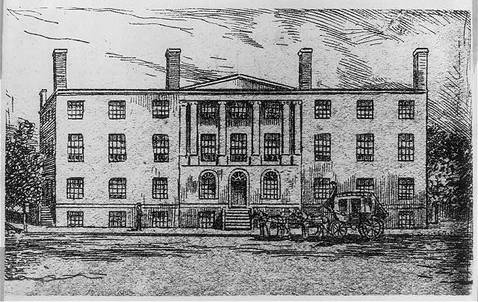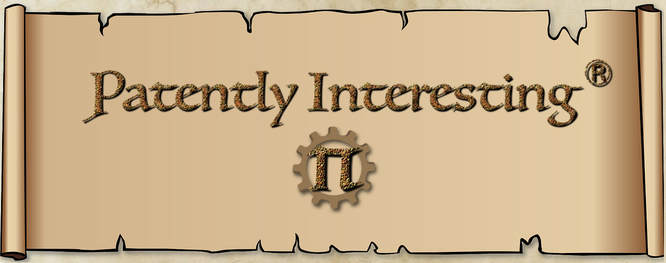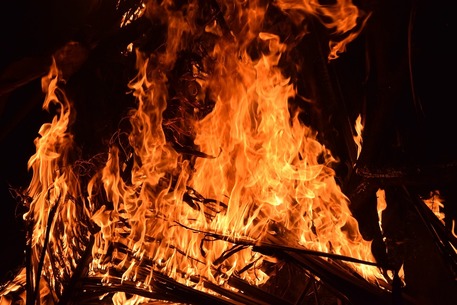 Blodgett's Hotel
Blodgett's Hotel
In the early morning of December 15th, 1836, Blodgett's Hotel in Washington D.C. burst into flames, destroying the U.S. Patent Office that was housed inside. The destruction was complete; every patent paper, reference book and patent model in the Patent Office was destroyed. The only property of the Patent Office that survived the fire was a book,The Repertory of the Arts and Manufactures for 1797, which had been illegaly borrowed from the Patent Office library by a draftsman.
From its inception up to the time of the fire, the Patent Office had issued over 10,000 patents. The original invention descriptions of these patents were lost forever. The catalogue of destruction further included over 7,000 patent models, 230 volumes of scientific books and 26 large folios containing over 9,000 drawings, many of which were works of art in their own right. The loss to the U.S. and to humanity in general was staggering. What makes this loss so unforgivable is that it was entirerly foreseeable and preventable. Blodgett's Hotel was a known fire trap and construction was already under way for a new, fireproof building for the Patent Office.
Built in 1793, Blodgett's Hotel was a wooden structure with three floors, an attic and a dirt floor cellar. In addition to housing the Patent Office, the building housed the headquarters of the General Post Office and the Washington City Post Office. The General Post Office occupied three-fifths of the building. The first floor of the other two-fifths was occupied by the City Post Office, while the Patent Office occupied the second and third floors above the City Post Office, as well as most of the attic of the entire building. Firewood was stored in the cellar, along with the likely source of the fire. Against established protocol, employees of the City Post Office and the Patent Office stored the ashes from their fires in the cellar, together with the firewood. Employees of the General Post Office simply dumped their ashes in the street, along with piles of garbage dumped there by others. It is thought that hot ash in the cellar started the blaze.
When the fire broke out in the cellar, little could be done to save Blodgett's Hotel. The building had been provided with a fire engine and a volunteer fire company had been formed to man it. However, by the time of the fire, the fire engine had fallen into disrepair and the fire company had disbanded for lack of interest. A bucket brigade was formed, but was of little effect.
In the aftermath of the fire, Congress passed a bill to restore the burned patent records. Pursuant to the bill, all patentees were requested to return their patents to the Patent Office for copying and the most important of the destroyed models were to be rebuilt from available information. No destroyed patent was to be deemed valid and enforceable until it was returned to the Patent Office and copied. Ultimately, 2,845 patents were restored and about 3,000 models were rebuilt.
From its inception up to the time of the fire, the Patent Office had issued over 10,000 patents. The original invention descriptions of these patents were lost forever. The catalogue of destruction further included over 7,000 patent models, 230 volumes of scientific books and 26 large folios containing over 9,000 drawings, many of which were works of art in their own right. The loss to the U.S. and to humanity in general was staggering. What makes this loss so unforgivable is that it was entirerly foreseeable and preventable. Blodgett's Hotel was a known fire trap and construction was already under way for a new, fireproof building for the Patent Office.
Built in 1793, Blodgett's Hotel was a wooden structure with three floors, an attic and a dirt floor cellar. In addition to housing the Patent Office, the building housed the headquarters of the General Post Office and the Washington City Post Office. The General Post Office occupied three-fifths of the building. The first floor of the other two-fifths was occupied by the City Post Office, while the Patent Office occupied the second and third floors above the City Post Office, as well as most of the attic of the entire building. Firewood was stored in the cellar, along with the likely source of the fire. Against established protocol, employees of the City Post Office and the Patent Office stored the ashes from their fires in the cellar, together with the firewood. Employees of the General Post Office simply dumped their ashes in the street, along with piles of garbage dumped there by others. It is thought that hot ash in the cellar started the blaze.
When the fire broke out in the cellar, little could be done to save Blodgett's Hotel. The building had been provided with a fire engine and a volunteer fire company had been formed to man it. However, by the time of the fire, the fire engine had fallen into disrepair and the fire company had disbanded for lack of interest. A bucket brigade was formed, but was of little effect.
In the aftermath of the fire, Congress passed a bill to restore the burned patent records. Pursuant to the bill, all patentees were requested to return their patents to the Patent Office for copying and the most important of the destroyed models were to be rebuilt from available information. No destroyed patent was to be deemed valid and enforceable until it was returned to the Patent Office and copied. Ultimately, 2,845 patents were restored and about 3,000 models were rebuilt.


